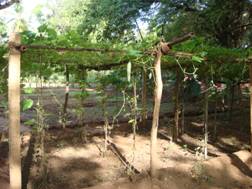know about Bhagawa[variety] -
| |
The ‘Bhagawa’ variety of pomegranate presently under commercial cultivation known by different
names viz. ‘Shendari’, ‘Ashtagandha’, ‘Mastani’, and ‘Red Daina’ in various districts of Maharashtra and madhyapradesh such as Solapur, Nashik,Sangli,Satara,
khargone,badwani,Ahemadnagar, Pune and Dhule districts.
| |
Extensive survey work on pomegranate orchards indicated that the ‘Bhagawa’ variety of pomegranate is heavy yielder and possesses desirable fruit characters. This variety matures in 180-190 days with average yield of 30.38 kg fruits/tree. Bigger fruit size, sweet, bold and attractive arils, glossy, very attractive saffron coloured thick skin makes it suitable for distant markets. This variety was found less susceptible to fruit spots and thrips as compared to other varieties of pomegranate. Considering all these attributes, the ‘Bhagawa’ variety is recommended for its cultivation in pomegranate growing in regions of Maharashtra and madhyapradesh.
| |
some important features of ‘Bhagawa’-
| |
It fetches better market price which is 2-3 times higher than that of Ganesh.
| |
Increasing demand for export markets particularly in United Kingdom, Holland, other European and gulf countries etc.
| |
Fruits are very attractive, ‘Saffron’ coloured, smooth and glossy peel which is increasing its cosmetic value and market appearance of the fruits.
| |
Fruits are with attractive sseds having cherry red coloured and bold arils, which are suitable for both table and processing purposes.
| |
Fruits are suitable for long distant transport due to thick peel (Less weight loss, less possibility of damage due to bruises.)
| |
Fruits have better keeping quality than other varieties ( 15 – 12 days at room temperatures).
| |
Fruits are tolerant to thrips and mites whcih reduces the number of pesticidal sprays, which minimises cost of production.
| |
Fruits are moderately susceptible to black spots.
| |
Fruits are free from blackening of arils even in case of late harvesting of fruits up to 7-5 months, which reduces market value of fruits.
| |
It has no incidence of cracking of fruits which is observed in other varieties viz. Ganesh, G-137 and Mridula which ranges from 10-15%.
| |
There is no fruit drop observed in case of severe water shortage situations.
| |
This variety gives high yield (30-40 kg/tree) in case of better management .
| |
It is comparatively late for harvesting but due to less expenses on plant protection measures and better market prices realized, it is more remunerative than any other pomegranate.
| |
Also see the video below-
A success story of 1 corore of pomegranate......


